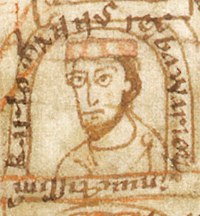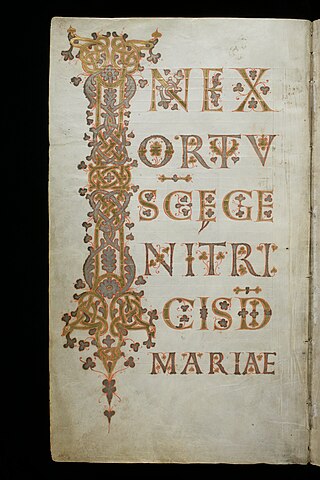
The Abbey of Saint Gall is a dissolved abbey (747–1805) in a Catholic religious complex in the city of St. Gallen in Switzerland. The Carolingian-era monastery existed from 719, founded by Saint Othmar on the spot where Saint Gall had erected his hermitage. It became an independent principality between 9th and 13th centuries, and was for many centuries one of the chief Benedictine abbeys in Europe. The library of the Abbey is one of the oldest monastic libraries in the world. The city of St. Gallen originated as an adjoining settlement of the abbey. The abbey was secularized around 1800, and in 1848 its former church became a Cathedral. Since 1983 the abbey precinct has been a UNESCO World Heritage Site.

Gall according to hagiographic tradition was a disciple and one of the traditional twelve companions of Columbanus on his mission from Ireland to the continent. However, he may have originally come from the border region between Lorraine and Alemannia and only met Columbanus at the monastery of Luxeuil in the Vosges. Gall is known as a representative of the Irish monastic tradition. The Abbey of Saint Gall in the city of Saint Gallen, Switzerland was built upon his original hermitage. Deicolus was the elder brother of Gall.

Notker the Stammerer, Notker Balbulus, or simply Notker, was a Benedictine monk at the Abbey of Saint Gall active as a poet, scholar and (probably) composer. Described as "a significant figure in the Western Church", Notker made substantial contributions to both the music and literature of his time. He is usually credited with two major works of the Carolingian period: the Liber Hymnorum, which includes an important collection of early sequences, and the earliest biography of Charlemagne, Gesta Caroli Magni. His other works include a biography of Saint Gall, the Vita Sancti Galli, and a martyrology.

The Winchester Troper refers to two eleventh-century manuscripts of liturgical plainchant and two-voice polyphony copied and used in the Old Minster at Winchester Cathedral in Hampshire, England. The manuscripts are now held at Cambridge, Corpus Christi College 473 and Oxford, Bodleian Library Bodley 775 . The term "Winchester Troper" is best understood as the repertory of music contained in the two manuscripts. Both manuscripts contain a variety of liturgical genres, including Proper and Ordinary chants for both the Mass and the Divine Office. Many of the chants can also be found in other English and Northern French tropers, graduals, and antiphoners. However, some chants are unique to Winchester, including those for local saints such as St. Æthelwold and St. Swithun, who were influential Bishops of Winchester in the previous centuries. Corpus 473 contains the most significant and largest surviving collection of eleventh-century organum. This polyphonic repertoire is unique to that manuscript.

The Folchart Psalter, or Folchard Psalter, is a Carolingian illuminated manuscript. It was produced about 872–883 in the scriptorium of the Abbey of St. Gall, Switzerland, under the direction of the scribe Folchardus, usually modernized as Folchard or Folchart.

Notker Labeo, also known as Notker the German or Notker III, was a Benedictine monk and the first commentator on Aristotle active in the Middle Ages. "Labeo" means "the thick-lipped one". Later he was named Teutonicus in recognition of his services to the German language.
The Saint Martial School was a medieval school of music composition centered in the Abbey of Saint Martial, Limoges, France. Most active from the 9th to 12th centuries, some scholars describe its practices, music, and manuscripts as 'Aquitanian'. It is known for the composition of tropes, sequences, and early organum. In this respect, it was an important precursor to the Notre Dame School. Adémar de Chabannes and his nephew Roger de Chabannes were important proponents of this school.
Celtic chant is the liturgical plainchant repertory of the Celtic rite of the Catholic Church performed in Britain, Ireland and Brittany. It is related to, but distinct from the Gregorian chant of the Sarum use of the Roman rite which officially supplanted it by the 12th century. Although no Celtic chant was notated, some traces of its musical style are believed to remain.
Ekkehard IV was a monk of the Abbey of Saint Gall and the author of the Casus sancti Galli and Liber Benedictionum.
Notker Physicus, sometimes called Notker II, was a monk at the Abbey of Saint Gall, active as a physician, painter, and composer. Besides physicus, he was also nicknamed piperis granum on account of his strict discipline.
A tonary is a liturgical book in the Western Christian Church which lists by incipit various items of Gregorian chant according to the Gregorian mode (tonus) of their melodies within the eight-mode system. Tonaries often include Office antiphons, the mode of which determines the recitation formula for the accompanying text, but a tonary may also or instead list responsories or Mass chants not associated with formulaic recitation. Although some tonaries are stand-alone works, they were frequently used as an appendix to other liturgical books such as antiphonaries, graduals, tropers, and prosers, and are often included in collections of musical treatises.
Ekkehard II, called Palatinus, was a monk of the Abbey of Saint Gall who became known for his sequence poetry.
Ekkehard V, called Minimus, was a monk of the Abbey of Saint Gall. He is the last of the Saint Gall Ekkehards, and flourished towards the end of the twelfth, and the beginning of the thirteenth, century. No particulars are known concerning his life, and tradition is silent as to his origin, the year of his birth and of his death. He was dean of the abbey in the reign of Innocent III.
1st millennium BC in music – 1st millennium in music – 11th century in music
Ratpert of St Gallen was a scholar, writer, chronicler and poet at the Abbey of Saint Gall. He wrote in Medieval Latin and in Old High German.
Craloh was abbot of the Benedictine Abbey of Saint Gall from 942 to 958. During his time in office, the first anti-abbot was elected.
Purchart was abbot of the Abbey of Saint Gall from 1001 to 1022.

The Evangelium longum is an illuminated manuscript Latin evangeliary that was made around 894 at the Abbey of Saint Gall in Switzerland. It consists of texts drawn from the Gospels for the use of the preacher during Mass.

The Codex Sangallensis 484 is an early medieval music manuscript, produced in the abbey of St. Gallen and stored in the Abbey Library in St. Gallen. The manuscript is known for its exhaustive collection of so-called tropes, meaning melodic or textual extensions to previously existing liturgic chants. As this particular manuscript is among the most extensive collections of such tropes from the eastern Frankish kingdom, it plays an important role in the history of music.

The Codex Sangallensis 381 is an early medieval music manuscript, produced in the abbey of St. Gallen and stored in the Abbey Library in St. Gallen. The manuscript is known for its exhaustive collection of so-called tropes, verses, and sequences. Together with the Cod. Sang. 484, this manuscript makes an important contribution to one of the most exhaustive collections of such compositions in the East Frankish kingdom and thus plays an important role in the history of music.










